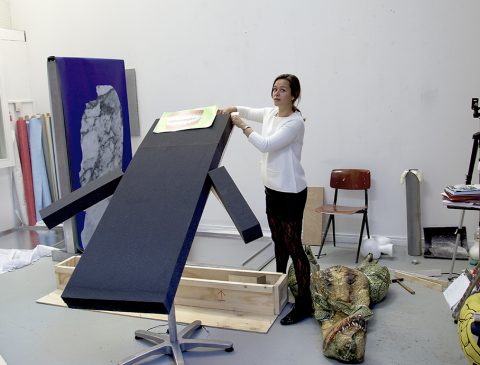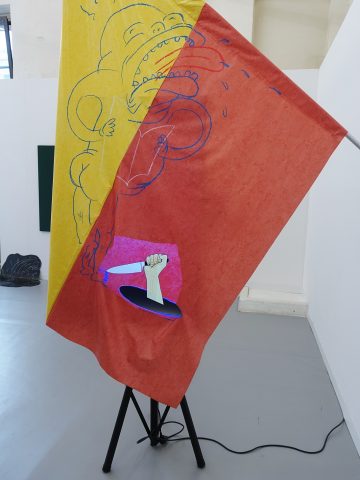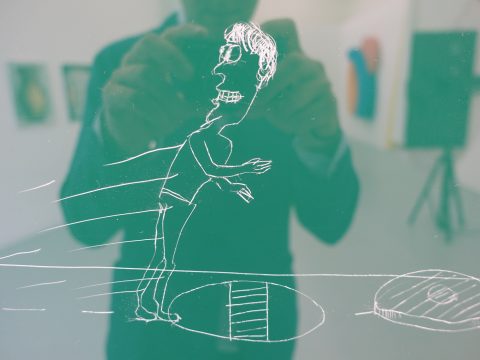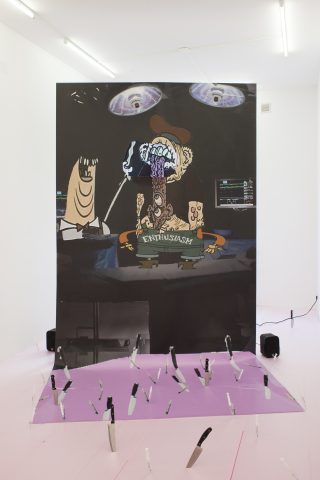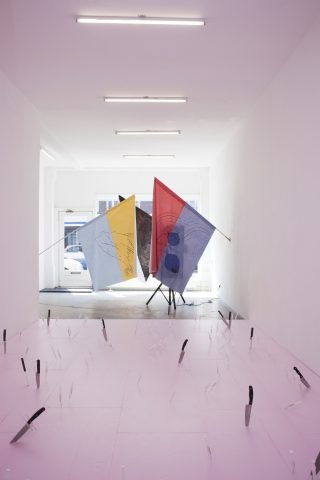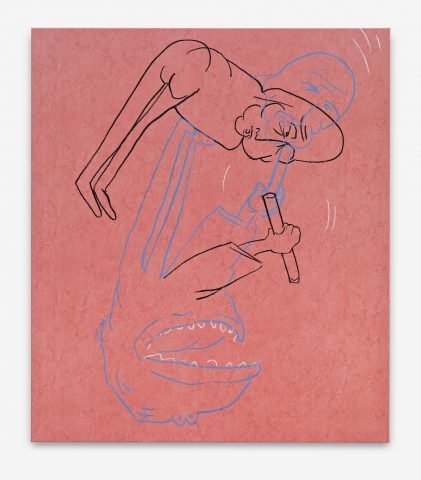To be discovered: Catherine Biocca and her flirtation with violence
- Catherine Biocca’s studio at Rijksakademie residency program, 2015.
- Catherine Biocca, White Onyx, 2016 /animated flag; video and audio installation, screen on screen-holder stand, industry marker and spray paint on wax cloth, aluminium pipe and flag holder.
- Catherine Biocca, 100 better ways to die, 2016; scratched varnish aluminium panel. Detail.
- Catherine Biocca, Double C Corporate Clay (2016); video and audio installation, metal rack, pvc print, screen and active speakers 280 x 200 x 150 cm.
- Catherine Biocca, Unfasten seat belt, at Jeanine Hofland, Amsterdam, installation view.
- Catherine Biocca, Tintoretto (from the series Animated paintings), 2016; Industry markers on wax cloth, 150 x 130 cm. Courtesy of the artist.
Most of the many experienced observers who visited the last edition of Liste art fair in Basel may have noticed that sharp knife repeatedly stabbing the feet of a screaming Homer Simpson like figure drawn over a red and yellow flag. And some of them may also remember the ironic cartoon scratched on the two varnished aluminium panels placed behind it – and titled 100 better ways to die. Well, the author of these engaging pieces is a gifted artist, Catherine Biocca, while the booth was that of Jeanine Hofland, who is also hosting in Amsterdam Biocca’s first gallery solo exhibition.
Biocca is half Italian and half German, and she studied Political Science in Rome, the city where she has spent most of her life before deciding she would become an artist. Then she moved to Düsseldorf, to study at the Kunstakademie with sculptor Georg Herold. “He taught me that the artistic work itself is very important – she said to CFA –, but it’s also important to enjoy the process of making it, and to keep on enjoying your work once it is completed”. Is there any more encouraging lesson for someone who decided to leave Rome’s sunny sky for the often grey German one? Probably not, however as soon as she graduated she moved to Amsterdam to attend the Rijksakademie residency program, where she could continue devoting herself completely to art.
According to Biocca, it has been not only a period of intense artistic research, but also a pivotal occasion to meet people and make connections. Among those who have visited her studio at the Rijksakademie she mentions Isabelle Cornaro, Nathaniel Mellors, Mike Nelson, and the art historian John Welchman, chairman of the Mike Kelly Foundation for Arts. “He has brought to my attention – she says about this latter – the importance of studying other artist’s writings in order to better understand where your thought is going and feel somehow less lonely in your studio”. Which is extremely important if you, like Biocca, are interested in the “interchangeability” of fundamental artistic tools such as image and movement. In fact, image is a two dimensional entity, generally depending on a support, while movement is characteristic of sculpture – which is three dimensional –, and performance based art (including film and video), that is time related. Thinking about these elements in term of interchangeability leads you to deal with the imaginary spaces in-between the known-dimensions. And that is probably the most ambitious challenge Biocca is facing at the moment by mixing two-dimensional not framed supports with video screens – in a way that seems to go beyond the solutions recently adopted by Turner Prize winner Laure Prouvost in her signature installations (such as for instance Farfromwords, from 2013). Also for Prouvost moving image and still image are related, but they clearly belong to separate dimensions. While, explains Biocca, “I would like to bring animation in the physical space in order to make the beholder part of the animation himself”. And the “sculptural” relevance she gives to the support set a distance between Biocca and the many artist that are using comics and cartoons references, like Sanya Kantarovsky, Vittorio Brodmann, Jack McConville, Ella Kruglyanskaya, or Alex Rathbone, just to name a few.
Moreover, Biocca is attracted by the way violence is represented by cartoon – she recently had a lecture about this topic at Institut Kunst HGK in Basel. “I am interested in what Germans call schadenfreude, which is that sort of pleasure derived by someone from another person’s misfortune,” she explains. And effectively the knife stubbing Homer Simpson at Liste returns in Amsterdam, in the company of a syringe, as key elements of the main piece of her current solo exhibition, Double C Corporate Clay (2016). Here the violence is expressed by the pain inflected to the vomiting monster from cartoon series The Marvelous Misadventures of Flapjack. It wears a overalls decorated with word “enthusiasm” and states in a mellow tone, with the sound of an heart beating in the background, that surgery is dangerous… “sometimes, but only if your surgeon is unprepared with something goes wrong”. Again, video animation and illustration are visually bound to each other, somehow inter-penetrated.
Complementary to this kind of installation pieces are what she calls “animated paintings”, which are sort of two dimensional illustrations drawn with industry markers on printed wax cloth. “I was looking for a new step in painting – she says – and I’ve started setting two collections. One of drawings, mainly illustrating different kind of violence, and one of titles”. Then the drawings are transferred onto the waterproof support and randomly linked to a title. As in the case of the two characters on a pink background (a man and a beast that may recall a detail from a Bosch’s painting), which are linked to the name of Tintoretto.
Like cartoon and animation, also the history of art is a recurring reference in Biocca’s unconscious. Giotto, Goya and Medieval elements pop up here and there in her pieces, sometimes also as little lenticular prints. As the artist told us, the idea itself of scratching varnished aluminium panels is somehow derived from the few writings etched by the so called Lanzichenecchi at the time of the Rome’s sack over Raphael’s Dispute about the Sacrament. “In this case the drawings are not by myself – she explains. They are drawn by a friend of mine on paper, and then I transfer them on the painted surface using some tools that I personally made for this purpose”. Perhaps it is not that important to know that her friend works in the real estate business, but you may need to know that it is quite common in Rome to find your car varnish scratched with keys, or other occasional tools, if you haven’t parked it properly. “Vandalism is just one of the many names violence may assume”, she comments, and cartoons are a way to put it differently. As, for instance, it happens in the slapstick comedy, that is another subject related to violence that the artist is interested in.
Catherine Biocca was born in 1984, and she is currently based in Berlin. In Amsterdam she is running a project space called Jolly Jocker, in collaborations with Benediket Hipp and Lisa Reitmeyer. She will took part to the 3rd Independent Animation Biennale in Shenzhen, China and later this year she is going to have her second gallery solo show at Frutta, in Rome. Then a third one will probably follow, at PSM gallery, in Berlin, in Spring 2017.
June 28, 2016

